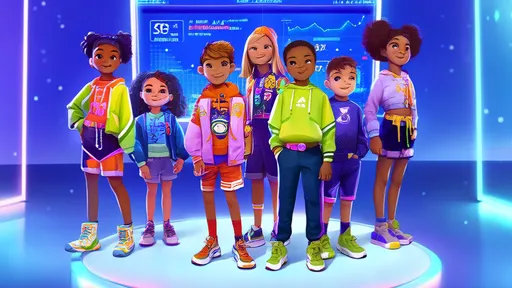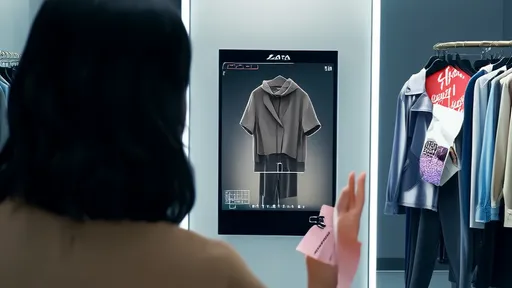The children's fashion industry is undergoing a seismic shift as Generation Alpha - the cohort born after 2010 - comes into focus as the most influential demographic in kids' apparel. Unlike previous generations who simply wore what their parents bought them, these digital-native children are asserting unprecedented influence over purchasing decisions, forcing brands to rethink everything from design to marketing strategies.
The Rise of the Kidfluencer Economy
What makes Gen Alpha fundamentally different is that they're the first generation to grow up with tablets in their hands from infancy. By age three, many can navigate YouTube better than their grandparents, and by six, they're making specific clothing requests based on what they've seen online. This has given birth to what analysts call the "kidfluencer" phenomenon - where children as young as five or six develop distinct fashion preferences influenced by social media personalities and unboxing videos.
Major retailers report that over 60% of parents now say their Gen Alpha children make specific brand requests when shopping for clothes. "My five-year-old asks for 'the dinosaur shirt from the Ryan video' or 'the light-up shoes like JoJo has,'" says one mother from Chicago. "It's not just about characters anymore - they know actual brand names and styles."
Digital Natives Demand Digital Experiences
The expectation for digital integration doesn't stop at discovery. Gen Alpha expects clothing to offer interactive elements that bridge physical and digital worlds. Augmented reality tags that unlock games or videos when scanned, QR codes that tell a story about how the garment was made, and even NFC chips that connect to loyalty programs are becoming standard features in forward-thinking children's brands.
This tech integration goes both ways - while kids want digital engagement, parents appreciate features that make clothing more functional. Apps that help track growth spurts to recommend sizing, digital wardrobe organizers that suggest outfits, and wash-care instructions delivered via scannable tags are winning over both generations.
Sustainability as a Non-Negotiable
Perhaps the most surprising aspect of Gen Alpha's influence is their early environmental consciousness. Having grown up with climate change as a constant dinner-table topic, these children are surprisingly vocal about sustainable fabrics and ethical production. Brands report children as young as seven asking whether materials are recycled or if workers were treated fairly.
This has led to an explosion of eco-innovation in children's wear - from biodegradable shoes that can be composted when outgrown to self-healing fabrics that extend garment life. "Our focus groups show Gen Alpha kids actually prefer 'planet-friendly' messaging over traditional cartoon characters," notes a product developer at a major European children's brand. "They want to feel like they're helping the Earth by what they wear."
The Gender Fluidity Revolution
Gen Alpha is also dismantling traditional gender norms in children's fashion at an unprecedented pace. Where previous generations might have had separate "boys" and "girls" sections, the newest cohort shows little interest in these distinctions. Retailers report that gender-neutral collections now account for nearly 30% of children's apparel sales, up from just 5% a decade ago.
This shift goes beyond color palettes. Brands are seeing demand for truly interchangeable styles - dresses with pockets and durability previously reserved for boys' clothing, or traditionally "girls'" floral patterns appearing on boys' t-shirts without comment. The generation that came of age seeing gender as a spectrum is voting with their wallets.
Micro-Trends and the 15-Minute Attention Span
The speed at which trends now move through children's fashion would be unrecognizable to previous generations. Thanks to TikTok and YouTube Shorts, styles that might have lasted a season now peak and disappear in weeks. This "micro-trend" phenomenon has forced brands to completely overhaul production cycles, with some introducing weekly drops instead of seasonal collections.
Interestingly, this hasn't led to more waste as feared, but rather to innovative rental and resale models. Subscription services where children receive a rotating wardrobe of trendy pieces, or peer-to-peer resale apps specifically for kids' fashion, are flourishing. Gen Alpha seems perfectly comfortable with the idea that clothing is temporary - a radical departure from the "special outfit" mentality of past generations.
The Parent-Child Negotiation Dynamic
The traditional parent-as-gatekeeper model has eroded. While parents still control the wallet, Gen Alpha has become remarkably skilled at negotiating purchases through what researchers call the "three E's" - education, engagement, and entertainment. Children come armed with product knowledge, often explaining features and benefits to parents. They engage through interactive in-store displays or apps. And they turn shopping into entertainment through gamified experiences.
Retailers are responding by creating hybrid spaces that appeal to both generations simultaneously - play areas with digital styling stations for kids adjacent to coffee bars for parents, or fitting rooms equipped with augmented reality mirrors that let children "try on" outfits virtually while parents check fabric details on their phones.
The Future Is Phygital
As Gen Alpha moves toward their tween years, the children's wear market shows no signs of slowing its transformation. The next frontier appears to be "phygital" clothing - garments that exist equally in physical and digital spaces. Several brands have already launched collections where each physical piece comes with a digital twin for use in metaverse environments, recognizing that for Gen Alpha, online identity matters as much as offline presentation.
What's clear is that children's fashion has moved far beyond simple protection or decoration. For Generation Alpha, clothing represents identity, values, and technological integration in ways we're only beginning to understand. The brands that will dominate this market aren't those that sell to children through their parents, but those that recognize Gen Alpha as sophisticated, values-driven consumers in their own right.

By /Jul 24, 2025

By /Jul 24, 2025

By /Jul 24, 2025

By /Jul 24, 2025

By /Jul 24, 2025

By /Jul 24, 2025

By /Jul 24, 2025

By /Jul 24, 2025

By /Jul 24, 2025

By /Jul 24, 2025

By /Jul 24, 2025

By /Jul 24, 2025

By /Jul 24, 2025

By /Jul 24, 2025

By /Jul 24, 2025

By /Jul 24, 2025

By /Jul 24, 2025

By /Jul 24, 2025